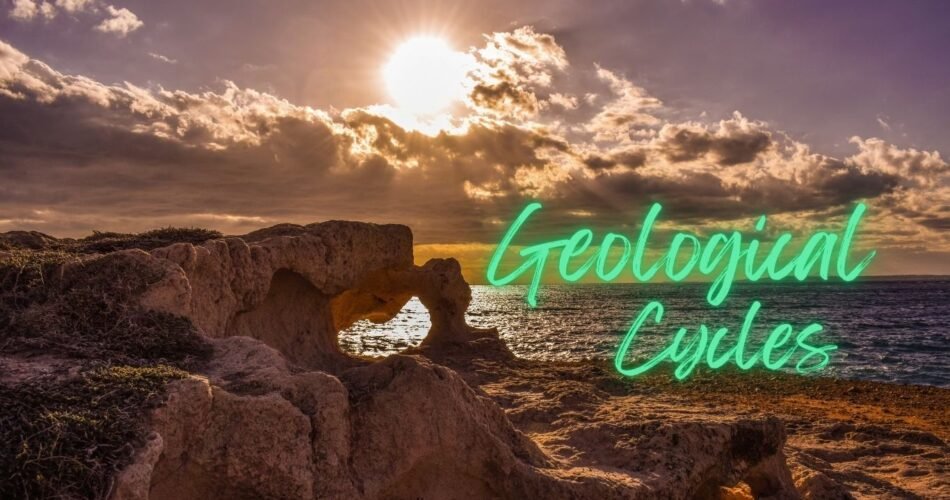This blog provides information about Geological Cycles. In the start, it introduces the term Cycle. Then it defines and explains Geological Cycles. It also elaborates the Tectonic Cycle of the Earth. Then it explains the Rock Cycle of Earth in detail. It also tells about the Hydrological Cycle of the Earth. Then it defines and explains the Biochemical Cycles along with detail of Carbon Cycle in the end. This blog contains Geological Cycles; Tectonic, Rock, Hydrological and Biochemical Cycles.
What is a Cycle?
A cycle is a series of events that are regularly repeated in the same order. Cycles are the main reason why all the natural systems works for a long term. Energy transfers in cycles on Earth. Earth systems and driving forces of Earth systems also works in cycles that includes many biotic and abiotic components of the Environment. Everything around us works as a cycle i.e. there is a cycle of birth to death, everyday cycle of day to night, in the same way nature undergoes many cycles to keep the Earth alive. We will learn about some of the Geological Cycles that exists on the Earth. This blog contains Geological Cycles; Tectonic, Rock, Hydrological and Biochemical Cycles.
What are Geological Cycles?
Throughout much of the 4.6 billion years of Earth history, the materials on or near the earth s surface have been created, maintained, and destroyed by numerous physical, chemical, and biological processes. Continuously operating processes produce the earth materials land, water, and
atmospheric necessary for our survival. Collectively, these all processes are referred to as Geological cycles.
These cycles makes us the Earth a living system in different ways. Geological cycles carry out processes between biotic and abiotic components of Earth. All of these makes cycles or cyclic processes out of them. These processes describe the complex relations between the component sub-cycles of tectonic, hydrologic, rock, and also biological cycle.
These cycles are very important in continuing the life on planet Earth. This blog will tell the detailed information about processes involved in Earth’s Natural Cycles or Geological Cycles, Tectonic, Rock, Hydrological and Biochemical Cycles.

1. The Tectonic Cycle:
The term tectonic refers to the large-scale geologic processes that deform the earth s crust, producing landforms such as ocean basins, continents, and mountains. Tectonic processes are driven by forces deep within the Earth. The outermost layer, called the lithosphere, is stronger and more rigid than deeper. material. Below the lithosphere lies the asthenosphere a, hot and plastically flowing layer of relatively low-strength rock that is present to a depth of about 250 km. Through detailed study of ocean basins and continents, earth scientists have established that the lithosphere averages about 100 km in thickness. Ranging from a few kilometers beneath the crests of mid-ocean ridges to 120 km beneath ocean basins to 20 to 400 km beneath continents.
The outer part of the lithosphere is the crust. Crustal rocks are less dense on the average than the rocks below , but oceanic crust is denser than continental crust. Oceanic crust is also thinner: The ocean floor has an average crustal thickness of about 7 km. Whereas continents are about 30 km thick on the average and up to 70 km thick beneath mountainous regions. Unlike the asthenosphere, thought to be more or less continuous, the lithosphere is broken into large pieces called lithospheric plates that move relative to one another. Processes associated with the origin, movement, and destruction of these plates are collectively known ap slate tectonics.
Tectonic processes occurring at plate boundaries largely determine the properties of the rocks and soils upon which we depend for construction and agriculture. In addition, plate motion over millions of years changes or modifies flow patterns in the oceans, influencing global climate as well as regional variation in precipitation. These changes affect the productivity of the land and its desirability as a place to live.
2. The Rock Cycle:
Rocks are aggregates of one or more minerals, naturally occurring crystalline substances with defined properties. We will discuss the properties of rocks and minerals, focusing here on the processes of the rock cycle , the largest of the geologic sub-cycles. This rock cycle is link to all the other sub-cycles. It depends on the tectonic cycle for heat and also energy. The biogeochemical cycle for materials, and the hydrologic cycle for water, which is used in the processes of weathering, erosion, transportation, deposition, and lithification of sediments.
Although rocks vary greatly in their composition and properties, they can classify into three general types, or families, according to how they form in the rock cycle. We may consider this cycle a worldwide rock-recycling process driven by the Earth’s internal heat, which melts the rocks subducted in the tectonic cycle. Crystallization of the molten rock produces igneous rocks beneath and on the Earth s surface. Rocks at or near the surface breakdown chemically and physically by weathering ,forming sediments that are transported by wind, water , and ice to depositional basins such as the ocean. The accumulated layers of sediment eventually undergo lithification (conversion to solid rock), forming sedimentary rocks .
The rock cycle is responsible for concentrating as well as dispersing materials, a fact that is extremely important to the mining of minerals. If it were not for igneous, sedimentary, and metamorphic processes that concentrate minerals, it would be difficult to extract these resources. We take resources that is concentrate by a rock-cycle process, transform them through industrial activities. Then return them in a dilute form to the cycle, where they are disperse by other earth processes.
3. Hydrological Cycle:
The hydrologic cycle is the movement of water from the oceans to the atmosphere and back again (Figure 2.11). Driven by solar energy, the cycle operates by way of evaporation, precipitation, surface runoff, and subsurface flow . Only a very small amount of the total water in the cycle is active near the earth s surface at any one time. For example, all water in the atmosphere, rivers, and shallow subsurface environment on earth is only about 0.3 percent of the total. This small amount of nonmarine water at or near the surface of the Earth is tremendously important in facilitating the movement. Sorting of chemical elements in solution, sculpturing the landscape, weathering rocks, transporting and depositing sediments, and providing our water resources.
4. Biochemical Cycle:
A biogeochemical cycle is the transfer or cycling of an element or elements through the atmosphere. Lithosphere(earths rocky outer layer), hydrosphere (oceans, lakes, rivers, and groundwater), and also biosphere (the part of the earth where life exists). It follows from this definition that biogeochemical cycles are intimately related to the tectonic, rock, and hydrologic cycles. The tectonic cycle provides water from volcanic processes, as well as the heat and energy required to form. It changes the earth materials transferred in biogeochemical cycles.
The rock and hydrologic cycles are involved in many transfer and storage processes of chemical elements in water, soil, and rock. Biogeochemical cycles can most easily be describe as the transfer of chemical elements. This happens through a series of storage compartments or reservoirs . When a biogeochemical cycle is highly understandable, the rates of transfer, or flux, between all of the known compartments. However, determining these rates on a global basis is a very difficult task. The amounts of such important elements as carbon, nitrogen, and phosphorus in each compartment. Their rates of transfer between compartments are only approximately in knowledge.
Carbon Cycle:
To better understand biogeochemical cycles, we will dis-cuss the global carbon cycle , diagrammed in Figure 2.12. Carbon in its pure form is present in some minerals such as graphite and diamonds. In recently discovered foreign molecules composed of 60 carbon atoms each and known as bucky balls. More important to us, however, are the many compounds carbon forms with other elements. Carbon is the basic building block of life, because it readily combines with other carbon atoms. It is with oxygen and hydrogen to form biological compounds. As a result, the carbon biogeochemical cycle is intimately related to the cycles of oxygen and hydrogen. Some carbon compounds are gases under ordinary conditions. The most important of these gases is carbon dioxide in the atmosphere, soil, and other parts of the environment.
Carbon in the Ocean:
The amount of carbon in the various storage compartments, as well as rates of transfer between compartments on an annual basis. The cycling of carbon between the atmosphere, oceans, and life is a relatively quick process. Over very long periods of geologic time, the carbon in the atmosphere is modulate by the carbonate-silicate cycle. Carbon dioxide in the atmosphere dissolves in water to form weak carbonic acid (H,CO3) that falls as rain. As the weak acid moves through soil and rock, it weathers the abundant silica rich rock. It releases a variety of weathered products including calcium ions (Ca?+) and bicarbonate (HCO3) ions.
When transports to the ocean by surface and ground water, calcium and also bicarbonate use by small floating marine organisms (plankton) to build their calcium carbonate shells. When they die and their shells sink to the bottom, they become sediment. The sediment accumulates and is take by moving plates of oceanic crust to subduction zones. With increase in temperature, pressure, and partial melting of subducted crust, the magma that feeds produces volcanoes . The CO, is back into the atmosphere with the volcanic eruptions. This provides, over geologic time (several hundred million years), a flux of carbon from the lithosphere to the atmosphere.
This blog contains Geological cycles i.e. Tectonic, Rock, Hydrological and Biochemical cycles.

To learn about more topics, click the links below:


Comments